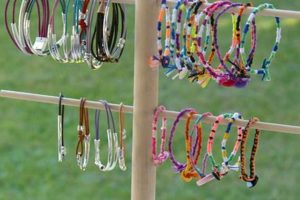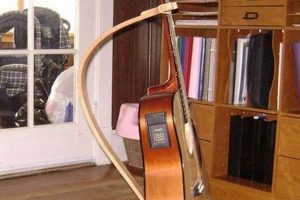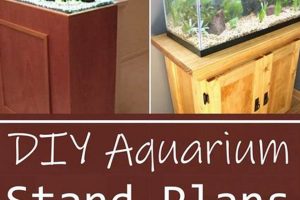A self-constructed structure designed to elevate and display floral arrangements. These constructions can range from simple, repurposed materials to more elaborate designs crafted from new lumber or metal. These personalized stands offer a creative outlet and a cost-effective alternative to purchasing commercially manufactured display pieces. For example, a tiered stand constructed from reclaimed wooden pallets can showcase a variety of potted plants on a patio.
The practice of creating personalized display solutions provides aesthetic advantages by allowing for customization to match specific dcor styles or event themes. This customization enables individuals to tailor the presentation of botanicals to suit their unique tastes and spatial constraints. Furthermore, the act of building such a structure often fosters a sense of accomplishment and resourcefulness, promoting sustainable practices through material reuse and creative problem-solving. Historically, the desire to elevate and showcase floral arrangements dates back centuries, with early examples using basic pedestals or repurposed household items.
The following sections will explore various design options, material choices, and construction techniques to enable the creation of visually appealing and structurally sound supports for botanical displays. Considerations for stability, weather resistance, and aesthetic integration will be addressed to guide the reader through the process of building a personalized display piece.
Tips for Constructing a Botanical Display Structure
This section provides essential guidance for building a stable, visually appealing, and long-lasting structure for the presentation of flora. These tips address key aspects of design, material selection, and construction techniques critical for a successful project.
Tip 1: Prioritize Structural Integrity: The base must be level and stable to prevent tipping. Reinforce joints with screws and adhesive for enhanced durability. Consider the weight capacity based on the intended plants and containers.
Tip 2: Select Weather-Resistant Materials: When intended for outdoor use, opt for treated lumber, cedar, or redwood to resist rot and insect damage. Apply a sealant or paint appropriate for exterior applications to further protect the structure.
Tip 3: Design for Proper Drainage: Incorporate drainage holes or shelves with adequate spacing to prevent water accumulation and potential damage to the stand and surrounding surfaces.
Tip 4: Optimize Height and Spacing: Consider the mature size of the plants to ensure sufficient vertical clearance and prevent overcrowding. Arrange plants to allow for adequate sunlight exposure and airflow.
Tip 5: Ensure Aesthetic Cohesion: Choose colors, textures, and styles that complement the existing dcor and landscape. Consider the overall visual impact and create a harmonious arrangement.
Tip 6: Pre-Drill Pilot Holes: This prevents wood splitting, especially when working with hardwoods or near edges. Accurate drilling is crucial for strong and lasting connections.
Tip 7: Apply a Protective Finish: A quality finish, such as varnish or paint, enhances the structure’s appearance and provides a protective barrier against moisture, UV radiation, and scratches.
Adhering to these guidelines contributes to the creation of a functional and aesthetically pleasing structure that effectively showcases botanical displays while ensuring durability and longevity.
The subsequent section will delve into specific design examples and project ideas, offering practical inspiration for constructing personalized botanical display structures.
1. Structural Integrity
Structural integrity is paramount in the creation of any self-constructed botanical display. It dictates the stability, load-bearing capacity, and longevity of the structure, ensuring it can safely and effectively support the intended floral arrangements.
- Material Strength and Selection
The inherent strength of the chosen material, be it wood, metal, or composite, directly influences the structure’s ability to withstand applied loads. Softwoods like pine offer ease of workability but may require reinforcement for heavier loads. Hardwoods, such as oak or maple, provide increased strength and durability. Metal, particularly steel, offers superior load-bearing capacity but necessitates welding or specialized joining techniques. Proper material selection is contingent upon the planned weight of the floral arrangements and environmental conditions.
- Joint Construction and Fasteners
The method of joining structural components is critical. Weak joints represent potential failure points. Screws, bolts, and adhesive create stronger bonds compared to nails or simple friction fits. Joinery techniques, such as mortise and tenon or dovetail joints, provide exceptional strength but require advanced woodworking skills. The choice of fasteners must consider the material being joined and the anticipated stress on the joint.
- Load Distribution and Support
The structure’s design must effectively distribute the weight of the floral arrangements across its various components. Uneven load distribution can lead to localized stress and potential failure. Reinforcement elements, such as cross-bracing or gussets, enhance stability and prevent warping or buckling. The base of the structure must provide a stable and level platform to prevent tipping or instability.
- Environmental Factors and Degradation
Exposure to environmental elements, such as moisture, sunlight, and temperature fluctuations, can compromise structural integrity over time. Wood is susceptible to rot and insect infestation, while metal can corrode. Protective coatings, sealants, and proper drainage mitigate these effects. Regularly inspecting and maintaining the structure prolongs its lifespan and ensures continued safety.
The aspects of material strength, joint construction, load distribution, and environmental factors are all intertwined and equally crucial. A failure in any one of these areas can compromise the entire botanical display. Careful consideration and meticulous execution are essential for a safe, durable, and aesthetically pleasing creation.
2. Material Selection
Material selection fundamentally dictates the aesthetic, durability, and structural integrity of a self-constructed botanical display structure. The choice of materials extends beyond mere availability and encompasses a range of considerations crucial to the final outcome.
- Wood Type and Characteristics
Different wood species possess varying degrees of strength, weather resistance, and aesthetic appeal. Softwoods like pine are easily workable but may require treatment for outdoor use. Hardwoods such as oak or maple offer increased durability but demand more specialized tools and techniques. Reclaimed wood introduces unique aesthetic qualities while promoting sustainable practices.
- Metal Considerations
Metal provides superior strength and load-bearing capacity compared to wood. Steel is a common choice, but requires rust-proofing to prevent corrosion. Aluminum is lightweight and corrosion-resistant, but its strength is less than steel. The use of metal may necessitate welding or specialized fasteners for secure assembly.
- Composite and Recycled Materials
Composites offer an alternative to traditional wood or metal, providing weather resistance and low maintenance. Recycled plastics and other repurposed materials present sustainable options for stand construction. The suitability of these materials depends on their structural properties and aesthetic compatibility.
- Finishes and Protective Coatings
Regardless of the primary material, appropriate finishes and coatings are essential for protecting the stand from environmental damage. Paints, stains, sealants, and varnishes enhance aesthetic appeal while providing a barrier against moisture, UV radiation, and insect infestation. The selection of the appropriate finish prolongs the structure’s lifespan and maintains its appearance.
The informed selection of materials, complemented by appropriate finishes, directly impacts the functionality and longevity of the stand. Each decision presents trade-offs between cost, durability, aesthetics, and ease of construction. Careful consideration of these factors ensures a finished product that effectively displays botanical arrangements while withstanding environmental conditions.
3. Weather Resistance
Weather resistance represents a critical consideration in the design and construction of self-made botanical display structures, particularly those intended for outdoor use. The capacity of a structure to withstand environmental elements directly affects its lifespan, structural integrity, and aesthetic appeal.
- Material Selection for Durability
The choice of materials significantly influences a stand’s ability to endure exposure to the elements. Untreated wood, for example, is susceptible to rot, insect infestation, and warping under prolonged moisture exposure. Selecting naturally weather-resistant materials like cedar, redwood, or treated lumber provides a foundational defense. Metal components require protective coatings to prevent rust and corrosion. The selection of these materials serves as the primary defense against weather-related degradation.
- Protective Coatings and Sealants
Beyond material selection, the application of protective coatings is crucial. Exterior-grade paints, stains, sealants, and varnishes form a barrier against moisture penetration, UV radiation damage, and temperature fluctuations. These coatings not only enhance the structure’s aesthetic appearance but also significantly extend its lifespan by preventing premature decay and deterioration. Regular reapplication of these coatings may be necessary to maintain their effectiveness.
- Drainage and Moisture Management
Effective drainage mechanisms are essential for preventing water accumulation, which can lead to rot and structural weakening. Designing the structure with adequate spacing between components and incorporating drainage holes allows water to escape freely. Elevated designs minimize contact with ground moisture, further reducing the risk of decay. Proper moisture management is a proactive approach to preserving the integrity of the structure.
- Design Considerations for Wind Resistance
In areas prone to high winds, the design must consider wind resistance to prevent toppling or structural damage. A low center of gravity and a wide base enhance stability. Securing the stand to the ground or utilizing weighted bases provides added protection against strong gusts. Open designs that allow wind to pass through minimize the potential for wind-induced stress on the structure.
The integration of weather-resistant materials, protective coatings, effective drainage, and wind-resistant design principles safeguards the investment and ensures the longevity of self-constructed botanical display structures. Overlooking these elements can lead to premature failure and necessitate costly repairs or replacements. A proactive approach to weather resistance is therefore essential for maximizing the value and lifespan of these structures.
4. Design Aesthetics
Design aesthetics play a crucial role in the creation of self-constructed botanical display structures. The visual appeal of the completed stand significantly impacts the overall presentation of the floral arrangements and its integration into the surrounding environment. Therefore, deliberate consideration of aesthetic principles is essential for a successful project.
- Form and Proportion
The overall shape and dimensions of the display stand directly influence its visual harmony. A balanced proportion between the height, width, and depth of the structure contributes to a sense of stability and visual appeal. For example, a tall, slender stand may complement minimalist dcor, while a wider, more substantial stand suits a rustic aesthetic. The form should complement the style of the home or garden.
- Material Palette and Texture
The selection of materials and their inherent textures plays a significant role in the stand’s aesthetic character. Natural wood tones create warmth and a connection to nature, while painted surfaces allow for customized color schemes. The contrast between smooth and rough textures adds visual interest. A stand constructed from reclaimed wood, for example, offers a unique texture and a sense of history, whereas a sleek metal stand conveys a modern aesthetic.
- Color Harmony and Contrast
The color scheme of the display stand should complement the surrounding environment and the floral arrangements it will hold. Harmonious color combinations create a sense of unity, while contrasting colors add visual impact. A neutral-colored stand allows the colors of the flowers to take center stage, while a brightly colored stand can serve as a focal point. The colors should enhance, not detract from, the floral display.
- Integration with Surroundings
A well-designed stand seamlessly integrates into its surroundings, complementing the existing dcor and landscape. Consider the architectural style of the home, the design of the garden, and the overall aesthetic of the space when selecting materials, colors, and forms. A rustic wooden stand blends harmoniously with a natural garden setting, while a modern metal stand complements a contemporary interior. Integration with the surrounding environment ensures the stand enhances, rather than clashes with, the existing aesthetic.
The interplay of form, material palette, color harmony, and environmental integration culminates in a botanical display stand that serves as both a functional support and an aesthetic enhancement. By carefully considering these design principles, the self-constructed structure elevates the presentation of floral arrangements and contributes to the overall visual appeal of its surroundings.
5. Weight Capacity
Weight capacity constitutes a critical design parameter for any self-constructed botanical display structure. This parameter directly dictates the range of floral arrangements the structure can safely support, preventing potential structural failure and ensuring the safety of surrounding individuals and property. The relationship between the materials used, the structural design, and the intended weight load determines the overall success and longevity of the unit.
Inadequate weight capacity can lead to catastrophic consequences. For instance, a stand constructed from insufficiently strong materials, such as thin, untreated wood, may buckle or collapse under the weight of several large potted plants. Conversely, a well-designed structure, utilizing reinforced joints and durable materials like treated lumber or steel, can support substantial loads without compromising structural integrity. A tiered stand designed to display multiple hanging baskets requires careful calculation of the weight of each basket, the soil, and the mature plant, plus consideration for water retention after rainfall.
Therefore, thorough assessment of weight capacity is indispensable. This assessment involves considering the maximum anticipated weight, selecting appropriate materials with known load-bearing capabilities, and implementing robust construction techniques. Ignoring this parameter can result in a hazardous situation, potentially causing damage to property or injury to individuals. Proper consideration for weight capacity provides a stable platform for botanical displays, enhancing both the aesthetic presentation and overall safety.
6. Drainage Solution
Effective drainage mechanisms are crucial for the long-term health and stability of self-constructed botanical display structures. These solutions prevent water accumulation, which can lead to material degradation, plant diseases, and structural instability. Proper drainage design requires careful consideration of materials, construction techniques, and the intended use environment.
- Material Selection and Water Permeability
The choice of materials impacts the overall drainage efficiency of the stand. Non-porous materials like plastic or metal require strategically placed drainage holes to prevent waterlogging, while more porous materials like untreated wood need protection against prolonged moisture exposure to avoid rot. Selecting appropriate materials based on their water permeability is essential for promoting healthy root systems and preventing structural damage.
- Design and Placement of Drainage Openings
The size, quantity, and placement of drainage openings significantly affect the rate at which excess water is removed from the stand. Insufficient drainage can lead to waterlogged soil, promoting root rot and fungal diseases. Conversely, excessively large openings may allow soil erosion. Strategic placement of drainage openings ensures efficient water removal without compromising the structural integrity or aesthetic appeal of the display.
- Surface Grading and Slope Considerations
Incorporating a slight slope or gradient into the design of the stand facilitates water runoff, preventing standing water from accumulating on surfaces. This is particularly important for tiered or multi-level designs. Surface grading ensures that water naturally flows away from the plants and the structure itself, minimizing the risk of water damage and promoting healthy plant growth.
- Integration with Watering Systems
Consideration of the watering system in relation to the drainage solution is vital. Automated irrigation systems, for example, require precise control to avoid overwatering and subsequent drainage issues. Integrating the drainage solution with the watering system ensures a balanced approach to plant hydration, preventing both drought and waterlogging. This integrated approach contributes to the long-term health and vitality of the displayed plants.
The integration of effective drainage solutions into self-constructed botanical display structures is not merely an aesthetic consideration; it is a fundamental requirement for the health of the plants and the longevity of the structure itself. By carefully considering material selection, drainage opening design, surface grading, and integration with watering systems, a stable, functional, and aesthetically pleasing display unit will result.
7. Construction Technique
Construction technique forms the backbone of any successful self-made botanical display project. The employed methods directly influence the stability, durability, and aesthetic presentation of the completed unit. Improper techniques invariably lead to structural weakness, premature failure, and a diminished visual appeal. The cause-and-effect relationship is clear: a meticulous approach to construction yields a robust and visually pleasing stand, while haphazard methods result in a substandard and potentially unsafe structure. This critical component underpins the entire concept, transforming a simple idea into a functional reality. A real-world example of this principle is evident in the difference between a stand assembled using only nails versus one constructed with screws, adhesive, and properly aligned joints. The latter provides significantly greater load-bearing capacity and resistance to environmental stressors. The practical significance of understanding and implementing sound construction techniques cannot be overstated; it determines the longevity and utility of the display.
Further analysis reveals the diverse range of techniques applicable to these projects, each with its specific advantages and limitations. Basic woodworking skills, such as accurate measuring, cutting, and joining, are essential for constructing wooden stands. Metalworking techniques, like welding or brazing, enable the creation of stronger and more intricate designs. The choice of technique should align with the project’s complexity, the available tools, and the builder’s skill level. For instance, a simple A-frame stand can be easily constructed using basic woodworking, while a tiered, multi-level stand requires more advanced joinery techniques to ensure structural integrity. Practical applications also necessitate consideration of safety protocols. The use of power tools demands adherence to safety guidelines, including eye protection, hearing protection, and proper tool handling. Secure work areas and careful planning are crucial for preventing accidents and ensuring a safe construction process.
In conclusion, the implementation of appropriate construction techniques is paramount to the successful creation of a durable and aesthetically pleasing display. Overlooking these techniques inevitably results in a compromised structure prone to premature failure. The challenges associated with mastering these skills are often outweighed by the satisfaction of creating a personalized and functional botanical display. Understanding the fundamental principles of construction connects directly to the broader theme of sustainable living and creative resourcefulness. The mastery of these techniques leads to projects that will stand the test of time.
Frequently Asked Questions
This section addresses common inquiries and misconceptions related to the design, construction, and maintenance of self-constructed botanical display structures. These questions aim to provide clarity and guidance for individuals undertaking such projects.
Question 1: What is the minimum level of woodworking experience required to construct a stable botanical display?
A foundational understanding of basic woodworking principles, including accurate measurement, safe cutting techniques, and secure joint construction, is recommended. While simple designs can be executed with minimal experience, more complex structures necessitate advanced skills to ensure structural integrity.
Question 2: What are the most cost-effective materials for building a weather-resistant outdoor display?
Treated lumber and reclaimed wood, when properly sealed, offer a balance of affordability and durability for outdoor use. Alternative options include recycled plastics and composite materials, although their initial cost may be higher.
Question 3: How can the weight capacity of a botanical display stand be accurately determined?
The weight capacity calculation should consider the combined weight of the planter, soil, mature plant, and potential water retention. Consultation of material specifications and load-bearing charts is recommended to ensure the selected materials can safely support the anticipated load. Overestimation of the weight is preferred to underestimation.
Question 4: What are the primary causes of structural failure in self-constructed botanical displays?
The most common causes include inadequate joint construction, use of inappropriate materials for the intended load, lack of weather protection, and uneven weight distribution. Regular inspection and maintenance can mitigate these risks.
Question 5: How frequently should a botanical display stand be inspected for structural integrity?
Displays, particularly those located outdoors, should be inspected at least twice annually: once in the spring, before the growing season, and again in the fall, before the onset of winter. This allows for timely identification and correction of any developing issues.
Question 6: What are the most effective methods for preventing rot and insect infestation in wooden botanical displays?
The application of wood preservatives, sealants, and exterior-grade paints offers a barrier against moisture and insects. Regular inspection for signs of damage, coupled with prompt treatment, can prevent significant structural deterioration.
The information presented in these FAQs aims to address practical concerns and promote informed decision-making in the construction of botanical display structures. Understanding these principles contributes to safer, more durable, and aesthetically pleasing outcomes.
The following section will provide a summary of the key concepts covered in this article and offer final considerations for those planning a botanical display project.
Conclusion
This exploration of self-constructed botanical display structures underscores the multifaceted considerations inherent in their design and fabrication. From the foundational importance of structural integrity and appropriate material selection to the critical aspects of weather resistance and aesthetic integration, successful execution requires a synthesis of practical knowledge and informed decision-making. Neglecting any of these key elements can compromise the stability, longevity, and visual appeal of the finished product, ultimately diminishing its utility and value.
Therefore, individuals embarking on a botanical display project are urged to prioritize thorough planning, meticulous execution, and ongoing maintenance. The ability to craft a durable and aesthetically pleasing structure not only provides a functional platform for botanical displays but also fosters a sense of accomplishment and contributes to a more visually engaging environment. Such endeavors represent an investment in both the tangible and intangible aspects of living spaces.







